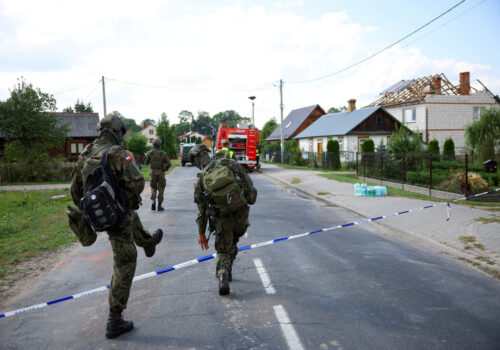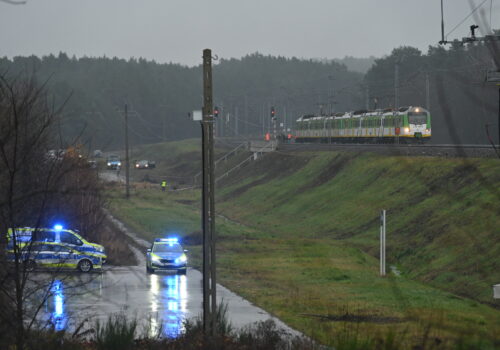WARSAW—In our recent travels in Eastern Europe, one important theme emerged: The honeymoon that followed this summer’s historic pledge by all thirty-two NATO member states to spend 5 percent of gross domestic product (GDP) on defense is now over. Slow growth rates and uneasy markets rattled by the tariff rollercoaster of 2025 have produced growing concerns in Europe about whether countries there can afford these commitments.
That cloud of doubt hung heavily over members of the Czech defense establishment who spoke with our Atlantic Council delegation in Prague last week. A range of defense, industry, and academic representatives shared their concerns about a possible reversal of defense commitments by the incoming government led by Andrej Babiš. The question about the long-term sustainability of high levels of defense spending has even been raised in Poland, despite that nation’s Alliance-leading defense expenditures (currently 4.12 percent) and the very real threat posed by Russia.
The latest act of apparent Russian sabotage—this month’s disruption of an eastern rail line in Poland that is critical for shipments to Ukraine—offered a sobering reminder of Poland’s urgent need to demonstrate military readiness and reestablish deterrence. We were on the ground in Warsaw when news of the railway incident broke and gripped a nervous nation. Poles understand the implications of sustained Russian aggression, but the dramatic scenes of sabotage were not enough to temper the concerns that government officials repeatedly expressed to us regarding the country’s fiscal woes and unsustainable defense spending.
Joined by Atlantic Council colleagues, we met last week with more than a dozen defense companies, venture capitalists, and senior national security professionals. In these meetings, we heard a consistent refrain: Polish defense-tech talent is real, but government structures are misaligned to the moment and impede innovation and economic growth. In particular, the government-owned giant Polska Grupa Zbrojeniowa (PGZ) lumbers as a slow-moving behemoth.
Tenders for government-funded defense support are now technically open to the private sector. But those involved in these processes told us that, in reality, few can compete because acquisitions continue to include a range of security requirements that result in incumbents (PGZ and a limited number of larger firms) running the table.
PGZ argues that the required capabilities are needed immediately, which it cites as the principal reason for purchasing US or European technologies that have been combat-proven in Ukraine, rather than investing in Polish systems that are still maturing through research and development (R&D) processes. This stands in contrast to the approach both Germany’s Bundeswehr and the British armed forces have taken toward Europe’s emerging defense startups—such as Stark, Alpine Eagle, or until recently Helsing—which have been contracted at earlier stages of development.
In most of PGZ’s public communications, however, it is primarily the subsidiaries that dominate these procurements, as was the case with the recent launch of testing of the American MEROPS drone-interception system. PGZ consistently emphasizes that it contracts such capabilities with the explicit assumption that they serve as bridging solutions, to be used only until national systems are developed. The technologies themselves are not lacking in Poland; yet under the current framework—where no R&D phase can be formally contracted—domestic solutions are effectively prevented from reaching product maturity, making it impossible for them to compete with fully developed foreign systems.
As a result, defense companies that make products such as cutting-edge satellites, attack drones, and command-and-control systems must look beyond Poland’s borders to grow. They often seek capital outside of Poland and then sell abroad to markets in Ukraine and elsewhere in Europe, limiting Poland’s ability to reap the benefits of these advanced technologies for its own purposes while also forfeiting the economic growth Warsaw says it desires.
Defense industry leaders told us that PGZ’s demise is already unfolding as it fails to fulfill orders on the timeline needed to provide the readiness and technological innovation that military planners are demanding. But this approach of allowing gradual atrophy in order to lessen political friction—a tactic deployed repeatedly in the early aftermath of Poland’s post-communist economic rebirth—is unsuited to addressing the country’s current and future challenges. If PGZ is left to decay gradually, Poland risks slowing its ability to re-establish deterrence with Russia, thereby compromising readiness for a true wartime footing and denying itself the potential economic dividends generated by spending 5 percent of GDP on defense.
In addition to PGZ reforms and broadening the competitive landscape, Poland must enable the capitalization of its defense companies through the inflow of foreign investment—especially US private equity and venture capital, which has become an increasingly active player in European defense and dual-use technologies. Creating clear pathways for such capital to enter the Polish market would unlock scale that domestic financing alone cannot provide. Likewise, Poland’s major defense enterprises should have the ability to structure and finance acquisitions in the form of joint ventures, allowing them to access advanced technologies, share risk, and accelerate export capacity.
Yet even robust capital flows will not deliver meaningful outcomes without changes to how Poland develops and procures military technology. Critically—and this would represent the single most consequential reform—Poland must begin contracting the R&D phase of defense products in close cooperation with the armed forces, ensuring that military users participate in shaping, testing, and iterating emerging technologies from the earliest stages. This stands in stark contrast to the current system, in which the Polish armed forces contract only fully mature products. In practice, testing is treated as the very first phase of procurement, meaning that a product must already be validated in the field before acquisition can begin. Earlier-stage technologies—those requiring prototyping, experimentation, or iterative refinement—cannot be procured under the existing framework.
This approach is reinforced by military regulations that prohibit meetings between commanders, senior leadership, and industry, as well as by a cultural posture that discourages early-stage collaboration and tolerates no errors during development. Overcoming these constraints and fostering a mindset in which iterative testing, controlled failure, and rapid learning are accepted as essential elements of technological maturation is crucial if Poland is to build a competitive defense innovation ecosystem capable of absorbing investment, scaling joint ventures, and ultimately delivering the capabilities needed for national security.
Taken together, such reforms would generate support for Polish firms, thereby obviating the need for Poland to look outside the country to meet its own defense needs and creating an opportunity to deliver the economic growth any government would desire. These efforts would deliver clear benefits to frustrated US companies eager to do business in a nation brimming with talent.
The potential for defense expenditures to serve as an engine of economic growth in Poland is real. But unlocking that potential requires reforms that align structures with needed outcomes. That’s an opportunity that both the US and Polish governments should seize.
Jenna Ben-Yehuda is the executive vice president of the Atlantic Council. She previously served as a military advisor, among other intelligence and policy roles, at the US State Department.
Jacek Siewiera is a nonresident senior fellow with the Atlantic Council’s Europe Center and a former national security advisor to the president of Poland.
Further reading
Wed, Sep 10, 2025
Experts react: Poland just shot down Russian drones over its territory. Is Putin ramping up his war on Europe?
New Atlanticist By
The Russian drones may have strayed from their original flight paths, or the Kremlin could be launching an aggressive new gambit against NATO.
Thu, Nov 20, 2025
Russia’s shadow war: How the Kremlin uses sabotage to wear down Europe
New Atlanticist By
Moscow’s goal is not just to damage infrastructure but also to sow distrust inside Western societies.
Wed, Nov 19, 2025
Dispatch from Warsaw: How to respond as Putin ratchets up the pressure
New Atlanticist By Daniel Fried
A suspected act of sabotage on a Polish railway line has highlighted the need for NATO countries to respond to Russian aggression.
Image: In Bytom, Poland, on November 21, 2025, Polish soldiers participate in the handover of the PILICA Anti-Aircraft Missile and Artillery System to the 34th Air Defense Missile Squadron. (Photo by Klaudia Radecka/NurPhoto via Reuters)




